- Home
- Tony Hillerman
Skinwalkers jlajc-7 Page 2
Skinwalkers jlajc-7 Read online
Page 2
A memo lay in his in-basket.
FROM: Captain Largo, Shiprock.
TO: Lieutenant Leaphorn, Window Rock.
"Three shots fired into trailer of Officer Jim Chee about 2:15 AM. this date, "the memo began. Leaphorn read it quickly. No description of either the suspect or the escape vehicle. Chee unharmed. "Chee states he had no idea of the motive," the memo concluded.
Leaphorn reread the final sentence. Like hell, he thought. Like hell he doesn't. Logically, no one shoots at a cop without a motive.
And logically, the cop shot at knows that motive very well indeed. Logically, too, that motive reflects so poorly upon the conduct of the policeman that he's happy not to remember it. Leaphorn put the memo aside. When the more normal working day began, he'd call Largo and see if he had anything to add. But now he wanted to think about his three homicides.
He swiveled his chair and looked at the reservation map that dominated the wall behind him. Three pins marked the unsolved homicides: one near Window Rock, one up on the Arizona-Utah border, one north and west in the empty country not far from Big Mountain. They formed a triangle of roughly equal sides—some 120 miles apart. It occurred to Leaphorn that if the man with the shotgun had killed Chee, the triangle on his map would become an oddly shaped rectangle. He would have four unsolved homicides. He rejected the thought. The Chee business wouldn't be unsolved. It would be simple. A matter of identifying the malice, uncovering the officer's malfeasance, finding the prisoner he had abused. It would not, like the three pins, represent crime without motive.
The telephone rang. It was the desk clerk downstairs. "Sorry, sir. But it's the council-woman from Cañoncito."
"Didn't you tell her I won't get in until eight?"
"She saw you come in," the clerk said. "She's on her way up."
She was, in fact, opening Leaphorn's door.
And now the councilwoman was sitting in the heavy wooden armchair across from Leaphorn's desk. She was a burly, big-bosomed woman about Leaphorn's middle age and middle size, dressed in an old-fashioned purple reservation blouse and wearing a heavy-silver squash blossom necklace. She was, she informed Leaphorn, staying at the Window Rock Motel, down by the highway. She had driven in all the way from Cañoncito yesterday afternoon following a meeting with her people at the Cañoncito Chapter House. The people of the Cañoncito Band were not happy with Navajo Tribal Police. They didn't like the police protection they were getting, which was no protection at all. And so she had come by the Law and Order Building this morning to talk to Lieutenant Leaphorn about this, only to find the building locked and only about two people at work. She had waited in her car for almost half an hour before the front door had been unlocked.
This discourse required approximately five minutes, giving Leaphorn time to think that the councilwoman had actually driven in to attend the Tribal Council meeting, which began today, that the Cañoncito Band had not been happy with the tribal government since 1868, when the tribe returned from its years of captivity at Fort Stanton, that the councilwoman unquestionably knew it wasn't fair to expect more than a radio dispatcher and a night staffer to be on duty at dawn, that the council-woman had gone over this complaint with him at least twice before, and that the council-woman was making a lot of her early rising to remind Leaphorn that Navajo bureaucrats, like all good Navajos, should be up at dawn to bless the rising sun with prayer and a pinch of pollen.
Now the councilwoman was silent. Leaphorn, Navajo fashion, waited for the signal that would tell him whether she had finished with what she had to say or was merely pausing to collect her thoughts. The councilwoman sighed, and shook her head.
"Not no Navajo police at all," she summarized. "Not one on the whole Cañoncito Reservation. All we got is a Laguna policeman, now and then, part of the time." She paused again. Leaphorn waited.
"He just sits there in that little building by the road and he doesn't do nothing. Most of the time he's not even there." The councilwoman, aware that Leaphorn had heard all this before, wasn't bothering to look at him while she recited it. She was studying his map.
"You call on the telephone and nobody answers. You go by there and knock, nobody home." Her eyes drifted from map to Leaphorn. She was finished.
"Your Cañoncito policeman is an officer of the Bureau of Indian Affairs," Leaphorn said. "He's a Laguna Indian, but he's actually a BIA policeman. He doesn't work for the Lagunas. He works for you." Leaphorn explained, as he had twice before, that since the Cañoncito Band lived on a reservation way over by Albuquerque, so far from the Big Reservation, and since only twelve hundred Navajos lived there, the Judicial Committee of the Tribal Council had voted to work out a deal with the BIA instead of keeping a full shift of the NTP stationed there. Leaphorn did not mention that the councilwoman was a member of that committee, and neither did the councilwoman. She listened with patient Navajo courtesy, her eyes wandering across Leaphorn's map.
"Just two kinds of pins on the Cañoncito," she said when Leaphorn had finished.
"Those are left over from before the Tribal Council voted to give jurisdiction to the Bureau of Indian Affairs," Leaphorn said, trying to avoid the next question, which would be What do the pins mean? The pins were all in shades of red or were black, Leaphorn's way of marking alcohol-related arrests and witchcraft complaints. The two were really Cañoncito's only disruptions of the peace. Leaphorn did not believe in witches, but there were those on the Big Reservation who claimed everybody at Cañoncito must be a skinwalker.
"Because of that decision by the Tribal Council, the BIA takes care of Cañoncito," Leaphorn concluded.
"No," the councilwoman said. "The BIA don't."
The morning had gone like that. The councilwoman finally left, replaced by a small freckled white man who declared himself owner of the company that provided stock for the Navajo rodeo. He wanted assurance that his broncos, riding bulls, and roping calves would be adequately guarded at night. That pulled Leaphorn into the maze of administrative decisions, memos, and paperwork required by the rodeo—an event dreaded by all hands in the Window Rock contingent of the tribal police. Before he could finish the adjustments required to police this three-day flood of macho white cowboys, macho Indian cowboys, cowboy groupies, drunks, thieves, con men, Texans, swindlers, photographers, and just plain tourists, the telephone rang again.
It was the principal of Kinlichee Boarding School, reporting that Emerson Tso had reopened his bootlegging operation. Not only was Tso selling to any Kinlichee student willing to make the short walk over to his place; he was bringing bottles to the dorm at night. The principal wanted Tso locked up forever. Leaphorn, who detested whiskey as ardently as he hated witchcraft, promised to have Tso brought in that day. His voice was so grim when he said it that the principal simply said thank you and hung up.
And so finally, just before lunch, there was time for thinking about three unsolved homicides and the question of coincidence. But first Leaphorn took the telephone off the hook. He walked to the window and looked out across the narrow asphalt of Navajo Route 27 at the scattered red-stone buildings that housed the government bureaucracy of his tribe, at the sandstone cliffs behind the village, and at the thunderclouds beginning to form in the August sky, clouds that in this summer of drought would probably not climb quite high enough up the sky to release any moisture. He cleared his mind of Tribal Council members, rodeos, and bootleggers. Sitting again, he swiveled his chair to face the map.
Leaphorn's map was known throughout the tribal police—a symbol of his eccentricity. It was mounted on corkboard on the wall behind his desk—a common "Indian Country" map published by the Auto Club of Southern California and popular for its large scale and its accurate details. What drew attention to Leaphorn's map was the way he used it.
It was decorated in a hundred places with colored pins, each color representing its own sort of crime. It was inscribed in a hundred places with notes written in Leaphorn's cryptic shorthand. The notes reminded Leaphorn of information he'd ac
cumulated in a lifetime of living on the reservation and half a lifetime of working it as a cop. The tiny q west of Three Turkey Ruins meant quicksand in Tse Des Zygee Wash. The r beside the road to Ojleto on the Utah border (and beside dozens of other such roads) recalled spots where rainstorms made passage doubtful. The c's linked with family initials marked the sites of summer sheep camps along the mountain slopes. Myriad such reminders freckled the map. W's marked places where witchcraft incidents had been reported. B's marked the homes of bootleggers.
The notes were permanent, but the pins came and went with the ebb and flow of misbehavior. Blue ones marked places where cattle had been stolen. They disappeared when the cattle thief was caught driving a truckload of heifers down a back road. Gaudy rashes of scarlet, red, and pink ones (the colors Leaphorn attached to alcohol-related crimes) spread and subsided inside the reservation with the fate of bootleggers. They made a permanent rosy blotch around reservation border towns and lined the entrance highways. Markers for rapes, violent assaults, family mayhem, and other, less damaging, violent losses of control tended to follow and mingle with the red. A few pins, mostly on the reservation's margins, marked such white-man crimes as burglary, vandalism, and robbery. At the moment, Leaphorn was interested only in three brown pins with white centers. They marked his homicides.
Homicides were unusual on the reservation. Violent death was usually accidental: a drunk stumbling in front of a passing car, drunken fights outside a bar, an alcohol-primed explosion of family tensions—the sort of unpremeditated violence that lends itself to instant solutions. When brown-and-white pins appeared, they rarely remained more than a day or two.
Now there were three. And they'd been stuck in Leaphorn's corkboard, and in his consciousness, for weeks. In fact, the oldest had been there almost two months.
Irma Onesalt was her name—pin number one. Leaphorn had stuck it beside the road between Upper Greasewood and Lukachukai fifty-four days ago. The bullet that killed her was a 30-06, the second most popular caliber in the world and the one that hung on the rifle rack across the rear window of every third pickup truck on the reservation, and around it. Everybody seemed to own one, if they didn't own a 30-30. And sometimes even if they did. Irma Onesalt, born to the Bitter Water Clan, born for the Towering House People, daughter of Alice and Homer Onesalt, thirty-one years old, unmarried, agent of the Navajo Office of Social Services, found in the front seat of her overturned Datsun two-door, hit in the jaw and throat by a bullet that smashed through the driver's-side window and, after destroying her, lodged in the opposite door. They had found a witness, more or less and maybe. A student from the Toadlena Boarding School had been enroute home to visit her parents. She had noticed a man—an old man, she'd said—sitting in a pickup truck parked about where the shot would have been fired from. That theory presumed that Irma Onesalt had lost control of the Datsun the moment she'd been hit. Leaphorn had seen the body. It seemed a safe presumption.
Pin two, two weeks later, represented Dugai Endocheeney, born to the Mud People, born for the Streams Come Together Clan. Maybe seventy-five, maybe seventy-seven, depending on whom you believed. Stabbed (the butcher knife left in his body) at the sheep pen behind his hogan on the Nokaito Bench, not far from where Chinle Creek runs into the San Juan River. Dilly Streib, the agent in charge, had said there was an obvious connection between pin one and pin two. "Onesalt didn't have any friends, and Endocheeney didn't have any enemies," Dilly had said. "Somebody is working from both ends. Going to keep knocking off good ones and bad ones until there's nothing left but the middle."
"Just us average ones," Leaphorn said.
Streib had laughed. "I think he'll get to you pretty quick, on the obnoxious end."
Delbert L. Streib wasn't your usual FBI agent. It had always seemed to Leaphorn, who had spent a tour at the FBI Academy and half his life running errands for the Agency, that Streib was smarter than most. He had a quick, innovative intelligence, which had made him a terrible misfit in the J. Edgar Hoover years and got him exiled to Indian country. But Streib, whose case it was since it was a homicide committed on a federal reservation, had drawn a blank on Onesalt. And on Endocheeney. And so had Leaphorn.
When he had seen Leaphorn's map, Streib had argued that pin two should be pin three. And maybe he was right. Leaphorn had assigned the third pin to Wilson Sam, born to the One Walks Around Clan, and born for the Turning Mountain People. The late Mr. Sam was fifty-seven, a herder of sheep who sometimes worked on Arizona Highway Department grader crews. He had been hit on the back of the neck with the blade of a shovel, so very, very hard that there was no question he had died instantly. But there was a question of when he had been hit. Sam's nephew had found the victim's sheepdog, voiceless from howling and half dead from thirst, sitting on the rim of Chilchinbito Canyon. Wilson Sam's body was on the canyon floor below—apparently dragged to the edge and tumbled over. The autopsy suggested a time of death about the same as Endocheeney's. So who died first? Anyone's guess. Again, no witnesses, no clues, no apparent motive, not much of anything except the negative fact that if the coroner was right, it would have been very difficult for the same man to have killed them both.
"Unless he was a skinwalker," Dilly Streib had said, looking somber, "and you guys are right about skinwalkers being able to fly, and outrun turbocharged pickup trucks, and so forth."
Leaphorn didn't mind Streib kidding him, but he didn't like anyone kidding him about witches. He hadn't laughed.
Remembering it now, he still didn't laugh. He sighed, scratched his ear, shifted in the chair. Staring at the map today took him exactly where it had taken him the last time he tried it. One pin was a Window Rock pin, relatively speaking. The first one. The next two were out-in-the-boondocks pins.
The first victim was a bureaucrat, younger, female, more sophisticated. Shot. The last two were men who had followed their flocks, traditional people, probably spoke little English, killed at close quarters. Did he have two separate cases? So it would seem. In the Window Rock case, premeditation—rarity of rarities on the reservation—was obvious. In the boondocks cases, it was possible but didn't look probable. A shovel hardly seemed a likely weapon of choice. And if you were determined to kill someone, most Navajos Leaphorn knew could take along an easier weapon than a butcher knife.
Leaphorn thought about his cases separately. He got nowhere. He thought about them as a trio. Same results. He isolated the Onesalt killing, considered everything they had learned about the woman. Mean as a snake, it seemed. People hesitated to bad-mouth the dead, but they had trouble finding good to say about Irma. No, Irma was a busybody. Irma was a militant. Irma was an angry young woman. Irma made trouble. As far as he could learn, she had no jilted lovers. In fact, the only one who seemed to mourn her aside from her immediate family was a longtime and apparently devoted live-in boyfriend—a schoolteacher at Lukachukai. Leaphorn always suspected devoted boyfriends in homicide cases. But this one had been standing in front of twenty-eight students talking about math when Onesalt was killed.
The mail arrived. Without breaking his concentration on the problem, idly, he sorted through it, mind still on Onesalt. Two telexes from the FBI were on top of the stack. The first one contained the details of the Jim Chee affair. He read the telex quickly. Nothing much new. Chee had not given chase. Chee said he had no idea who might have fired the shots. Tracks left by size seven rubber-soled running shoes had been found adjoining the trailer. They led about four hundred yards to a point where a vehicle had been parked. Tracks indicated worn tires. Drippage where vehicle had parked indicated either a lengthy stay or a serious oil leak.
Leaphorn set the message aside, expression glum. Again, no motive. But there was a motive, of course. When someone tries to ambush a cop there is a strong motive, and the motive tends to be unpleasant. Well, Chee was Captain Largo's boy, and finding out what Officer Chee was doing to provoke such a reaction would be Largo's problem.
The second telex reported that Agent Jay Kennedy of
the Farmington office would this date locate and interrogate subject Roosevelt Bistie in connection with the Dugai Endocheeney homicide. Two witnesses had been located who placed a vehicle owned by Bistie at the Endocheeney hogan at the time of the killing. Another witness indicated that the driver of the vehicle had said he intended to kill Endocheeney. Any officer with any information about subject Roosevelt Bistie was asked to contact Agent Kennedy.
Leaphorn turned the paper over and looked at the back. Blank, of course. He glanced at the map, mentally removing the Endocheeney pin. The triangle of unsolved crimes became a line—two dots and no real reason to link them. It looked suddenly as if his rash of homicides were, in fact, coincidences. Two unsolved was a hell of a lot better than three. And perhaps Bistie would also prove to be the Wilson Sam killer. That seemed logical. The lives of the two men might be linked in many ways. Leaphorn felt much better. Order was returning to his world.
The telephone buzzed.

 People of Darkness
People of Darkness Talking God jlajc-9
Talking God jlajc-9 Skinwalkers jlajc-7
Skinwalkers jlajc-7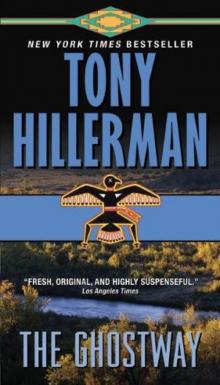 The Ghostway jlajc-6
The Ghostway jlajc-6 The Dark Wind jlajc-5
The Dark Wind jlajc-5 The Blessing Way
The Blessing Way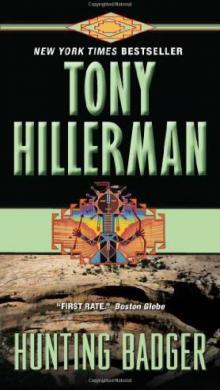 Hunting Badger jlajc-14
Hunting Badger jlajc-14 Seldom Disappointed: A Memoir
Seldom Disappointed: A Memoir Coyote Waits jlajc-10
Coyote Waits jlajc-10 Skeleton Man jlajc-17
Skeleton Man jlajc-17 The Shape Shifter
The Shape Shifter Sacred Clowns jlajc-11
Sacred Clowns jlajc-11 The Fallen Man jlajc-12
The Fallen Man jlajc-12 The First Eagle jlajc-13
The First Eagle jlajc-13 Listening Woman jlajc-3
Listening Woman jlajc-3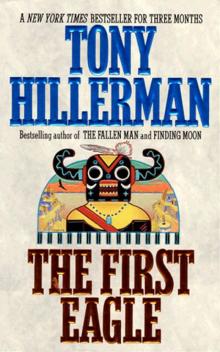 The First Eagle
The First Eagle Skeleton Man
Skeleton Man The Sinister Pig jlajc-16
The Sinister Pig jlajc-16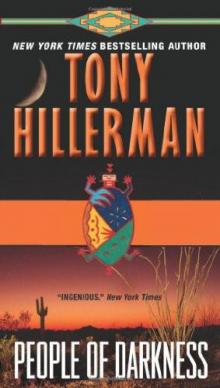 People of Darkness jlajc-4
People of Darkness jlajc-4 The Blessing Way jlajc-1
The Blessing Way jlajc-1 A Thief of Time
A Thief of Time The Wailing Wind
The Wailing Wind A Thief of Time jlajc-8
A Thief of Time jlajc-8 The Wailing Wind jlajc-15
The Wailing Wind jlajc-15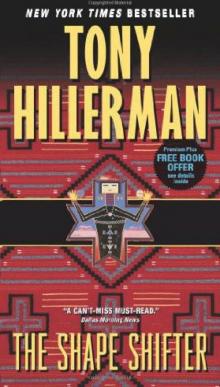 The Shape Shifter jlajc-18
The Shape Shifter jlajc-18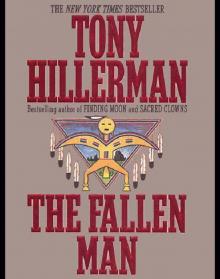 The Fallen Man
The Fallen Man Finding Moon
Finding Moon